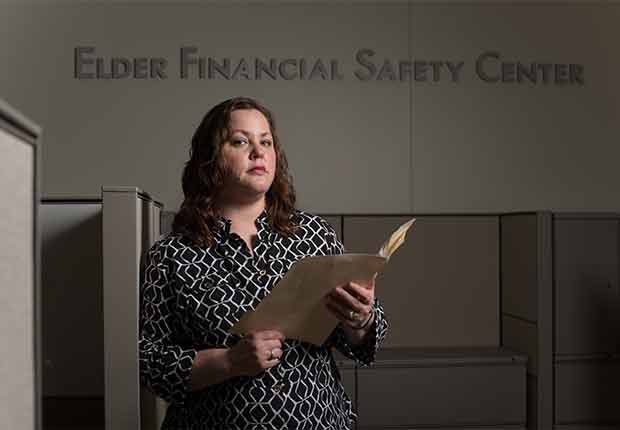AARP Hearing Center

By Thomas Korosec
Julie Krawczyk, director of the Elder Financial Safety Center, has seen a flood of cases like this: Four years ago, an 89-year-old Dallas woman, widowed with no family, moved to a care facility after she fell and broke her hip. She granted a friend from her church control of her finances and authority to act in her place.
The so-called friend abused that trust by liquidating $145,000 in stocks, selling the woman’s home and spending the proceeds on herself. The victim, who lives on a fixed income of $950 a month, is able to cover only a fraction of the charges at the facility where she lives today. She remains there only through their goodwill.
“The No. 1 type of exploitation we see is theft—theft of property, investments, credit cards. The perpetrator is often a family member or a longtime neighbor. Those relationships are so deep and trusting,” Krawczyk said.
The program she heads is an unusual two-year-old collaboration between a Dallas nonprofit—the Senior Source—and two government entities: the Dallas County District Attorney’s Office and the county’s probate courts. Together they address financial abuse of older people through prevention efforts, such as counseling and money management, and prosecution by a special unit dedicated to investigating and targeting financial crimes against older people.
A legislative solution?
Texas lawmakers have indicated they’ll address the issue of elder financial abuse next year. AARP Texas would like them to consider the Dallas program as a possible method that could be used in other jurisdictions.
Charlene Hunter James, president of AARP Texas, testified at a Texas Senate Business and Commerce Committee, hearing in January that the state should look to collaborative efforts such as the safety center to better protect older citizens.
“Addressing elder financial abuse is difficult but critical,” James told the Senate panel. “AARP views this as a community problem that requires a … community solution.”
She endorsed the formation of a task force composed of legislators and groups with significant experience dealing with elder abuse to recommend changes to state law. She also said the solution should include outreach and education, such as the AARP Fraud Watch Network (or 877-908-3360 toll-free), which alerts people of any age to con artists and scams.
Tim Morstad, associate state director of AARP Texas, said elder financial abuse has a lot of angles for lawmakers to explore. “There are ways to increase funding to crucial state agencies like Adult Protective Services,” he said. “The state Legislature can increase penalties to try to thwart more exploitation. There are definitions in the law that can be narrowed to help law enforcement take action against people who are committing these crimes.”
Financial abuse robs older Americans nationwide of over $3 billion every year, and that is just the amount reported, according to a MetLife study of elder financial abuse. The Elder Financial Safety Center, which is supported by a five-year grant from the W. W. Caruth Jr. Foundation at Communities Foundation of Texas, has demonstrated in its first two years of operation how widespread this form of elder abuse has become.
On her first day on the job, director Krawczyk recalled, “I wasn’t in the chair 10 minutes when a local businessman, a very successful 76-year-old, called and told me, ‘Well, I don’t have anything left. My son has taken everything.’ ”
When the center opened in 2014, the Dallas County District Attorney’s Office was handling 118 elder financial abuse cases. By the end of 2015, that had increased to 275, said Amy Croft, deputy chief prosecutor in the elder abuse unit.
Krawczyk noted that there is “a huge need” for the Elder Financial Safety Center. “We expected to see about 3,700 clients over the five years. We served 3,700 clients last year alone.”
Contact the center at 214-525-6130 or 214-823-5700 or email efsc@theseniorsource.org.
Thomas Korosec is a writer living in Dallas































































